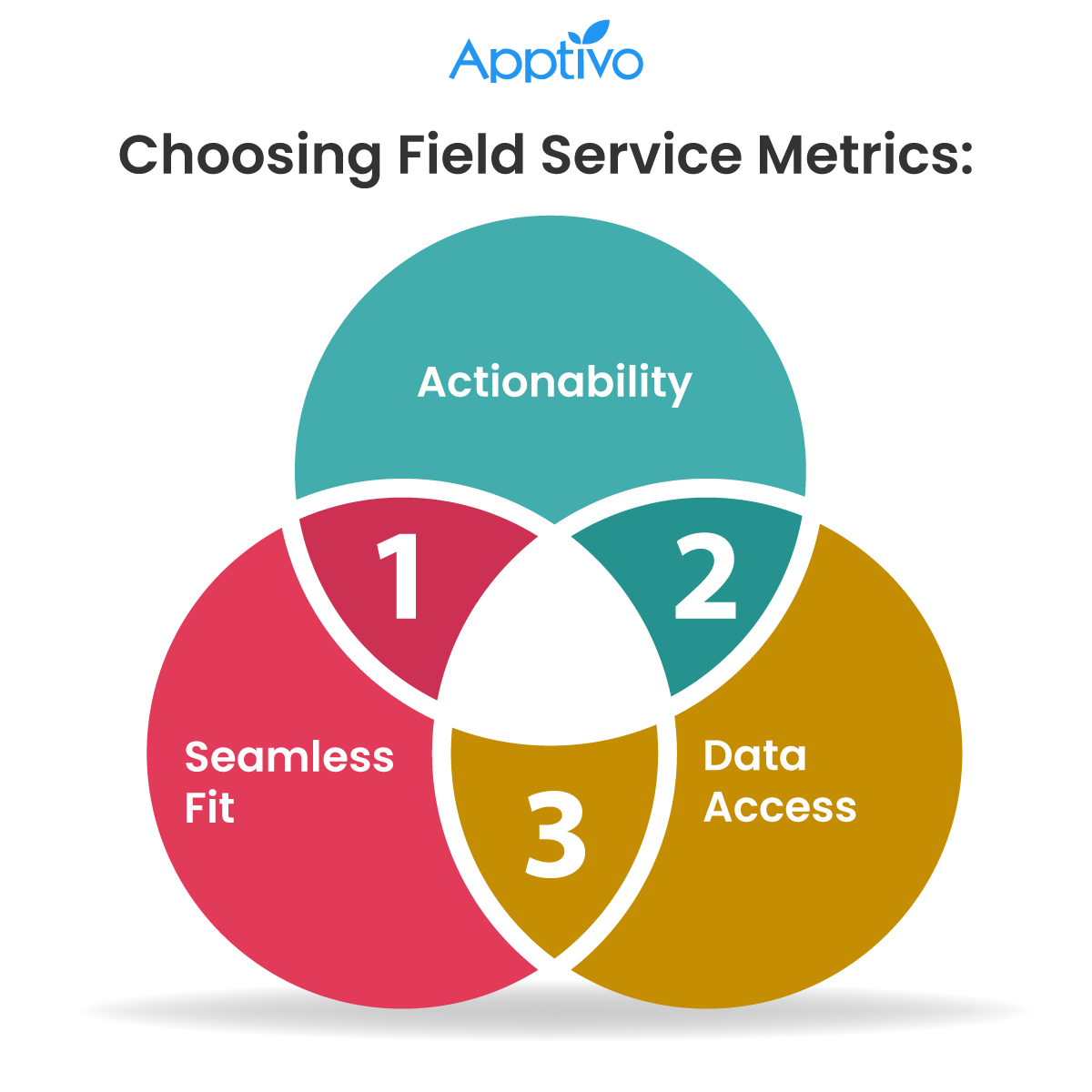 |
1. What Are Field Service Metrics?
2. Why is it important to set Metrics in field service?
3. Top 10 Customer-Centric Field Service Metrics
What Are Field Service Metrics?
Field service metrics refer to quantifiable data that assess the performance of work carried out for customers at locations outside the company’s premises. These metrics serve as a means to measure and evaluate various aspects of field service activities. Their primary purpose is to pinpoint and establish key performance indicators (KPIs) that gauge the effectiveness of field service operations.
Why is it important to set Metrics in field service?
Metrics are critical in a company’s path to achieve strategic and financial goals. They are useful decision-making tools for business owners and managers, providing a way to assess operational effectiveness and satisfy stakeholder interests.
Essentially, metrics transform business insights into quantifiable data, enabling organizations to develop and enhance their strategies. In the context of field service, these metrics are essential tools that allow service providers to monitor daily operations, gain insights into performance, and assess the attainment of predefined goals and objectives.
Top 10 Customer-Centric Field Service Metrics
The important field service performance metrics described below should be known and understood by businesses so that they may set realistic goals for their technicians and accurately assess their company’s performance.
CSAT(Customer Satisfaction)
Gauge the level of customer satisfaction and happiness regarding the service they’ve just experienced, typically gathered through surveys or feedback forms immediately after their interaction with a company or product.
For instance, imagine a customer who has just completed an online purchase from an e-commerce website. After finalizing their order and receiving their items, they might be prompted to rate their satisfaction with the overall shopping experience on a scale of 1 to 5. This real-time feedback helps the company understand how well they met the customer’s expectations and can make immediate improvements if necessary.
NPS (Net Promoter Score)
NPS is an important indicator for measuring customer happiness and loyalty through suggestions, assessing, and improving the customer experience by utilizing promoters, passives, and detractors. For more information, go here.
CES (Customer Effort Score)
Assess practical scenarios to see how easily customers may handle their complaints with a field service representative.
Let’s consider a scenario where a customer encounters a technical problem with their computer. They reach out to a company’s field service team for help. The field service expert’s skill in swiftly and effectively identifying and resolving the issue while ensuring the customer’s contentment provides a tangible, real-time demonstration of how the company manages customer issue resolution.
FRT (First Response Time)
The average time it takes an agent to respond to a customer’s query or support request is represented by FRT. Click here to learn more about FRT.
Average response time
The promptness with which a field service team leaps into action upon receiving emergency or break-fix calls is reminiscent of “capturing the moment.” Average response time acts as the measuring stick, quantifying the duration between the initial call or issue detection and the technician’s timely arrival at the scene to work their magic.
A delayed response time is comparable to “waiting for the stars to align.” It could be due to inefficient scheduling, an overburdened workload in comparison to available employees, or technicians performing at less than optimal efficiency.
When response times are prolonged, it’s as if customers are trapped in a life-long waiting room, enduring extended inconveniences or lower productivity. This is especially important when the item in question is critical to guaranteeing smooth operations.
The fallout from the situation has the potential to throw a shadow on uptimes, SLAs (Service Level Agreements), and the overall fabric of customer happiness.
To enhance average response times, the spotlight should be on:
- Quick and flexible scheduling that sends the closest or quickest available technician to assignments.
- Reducing travel, idle moments, or unproductive intervals for technicians.
- Streamlining procedures allows employees to do more jobs each day.
- If the current number of technicians falls short of meeting demand, consider extending the team by employing extra employees.
Service Resolution Rate
Track the amount of time it takes to thoroughly resolve the customer problems or issues, as demonstrated by real-time scenarios.
Consider an e-commerce consumer who claims an item missing from their order. The time it takes to remedy an issue is measured by the time it takes from the initial report to the moment the customer obtains the missing item.
Complaint resolution rate
Evaluate the efficiency and quickness with which customer complaints are handled, ensuring a good experience, as proven in actual situations.
Consider the following scenario: a client phones a mobile phone service provider to report a network outage. The time it takes the provider to find and correct the problem, eventually restoring the client’s network connectivity, serves as an actual time review of how successfully and quickly customer complaints are resolved to provide a positive experience.
Time to Site
The “time to site” metric reflects the timeless truth that time doesn’t wait. It measures how long it takes for technicians to arrive at a job site after being dispatched for immediate-response calls. A lower value in this metric indicates streamlined routes, minimizing travel time and maximizing the time available for resolving the issue at hand.
For businesses with connected solutions but lagging field service metrics, consider these actions:
- Route Optimization: Provide dispatchers with tools for efficient location management and route planning.
- Smart Planning: Using real-time analytics and AI recommendations, assign the appropriate personnel to jobs based on location, talents, and availability.
- Geolocation Tracking: Integrate GPS into the field service app for easy navigation and real-time resource visibility.
First-Time Fix Rates
The “first-time fix rate” is akin to acing a task on your initial attempt. It reveals how often jobs are successfully completed without the need for follow-up visits. Although not every task can be wrapped up in one go, this metric provides a strong indicator of overall efficiency and customer satisfaction.
When a technician is called back repeatedly, it’s like spinning your wheels: customers suffer more downtime and aggravation, and the technician wastes important time that may be better spent on new assignments.
Many issues may occur as a result of this, which can be properly addressed with the help of a Field Service App.
Call Volumes
Monitoring call volume is analogous to examining the dashboard of a car: it signals a problem, but users must examine it more deeply.
If there is an increase in business, consider hiring more employees, similar to increasing flight attendants during peak travel seasons.
Think ahead if there are recurring concerns. For example, tech support provides online real-time troubleshooting assistance, similar to how travelers check-in before a trip. This empowers customers while reducing phone volume.
Understanding the source and taking preventive steps can assist in handling high call volumes efficiently in both circumstances.
How to Choose the Right Field Service Metrics?
Choosing field service metrics that are most closely aligned with broad business objectives will have the most influence on the organization.
 |
Is Their Fit into the Business Puzzle Seamless?
When analyzing field service metrics, individuals must ensure that they are tightly aligned with their company objectives. Consider these measures to be a kind of compass. To demonstrate, if the main goal is to improve customer pleasure, it’s like setting a GPS to that exact location. Metrics such as CSAT and First-Time Fix Rate serve as GPS coordinates, providing continual input on whether the journey is on track or whether course modifications are required.
On the flip side, tracking metrics that have no correlation to these objectives is akin to following a GPS to a place that holds no relevance. For example, monitoring metrics like social media likes or website clicks, while intriguing, may not contribute to the primary goal of improving customer satisfaction or boosting revenue.
Choosing metrics that are in line with one’s goals guarantees that each step taken brings one closer to success. Avoiding irrelevant metrics is similar to removing unnecessary baggage on this journey, allowing for a more focused and efficient approach to achieving business goals.
Can It Be Acted Upon?
When one is in the process of choosing field service metrics, it’s essential to consider them as tools in the toolbox—each one should be useful and prepared for action. The goal is to focus on metrics that offer meaningful insights, guide decisions, and improve business practices.
Avoid “empty” metrics, which may resemble a puzzle piece with no place to fit. These indicators can provide a glimpse of the business’s performance, but they lack the power to drive change.
Monitoring “delays due to weather” is like tracking a wild goose; it highlights the influence of weather on productivity but does not provide a way for the business to change course. Concentrate on indicators that serve as actionable road signs, assisting the firm in effectively navigating its trip to improvement.
Is Data Access Available?
In the pursuit of effective metrics for field service, individuals should ensure they’re dealing with “apples they can pluck from the tree.” This means that any metric considered for tracking should be readily accessible and quantifiable.
Imagine wanting to measure customer satisfaction. If there’s no practical method for soliciting feedback and capturing responses, it’s like “chasing butterflies in the wind” – a challenging endeavor. Therefore, it’s essential to review one’s field service software to ensure it can supply the necessary metrics.
In essence, the choice of metrics should be like picking low-hanging fruit, readily available and easy to quantify, rather than pursuing elusive goals.
Footnotes
Choosing the right field service metrics is an important step that will determine both present performance and future resilience. It ensures that you continually provide the desired level of service to customers while also keeping your firm on track to meet its goals.
Often, the “what” we want from our business, processes, or service teams is clear. However, the challenge lies in dissecting the “why” and “how” aspects. This is where metrics come into play.
Metrics-driven by strategy enable you to thoroughly investigate the thinking behind your strategies as well as the tactics used to implement them. They also aid in the establishment of crucial milestones, which are a vital component of good planning and the achievement of targeted results.
Latest Blogs

Role Of CRM In Travel And Tourism Industry
Travel and tourism have been a significant part of everyone’s life since the ancient period. When we skim through the pages of history, It should be noted that humans were initially nomads before they became settled in one place. They...
Read more →
WHAT IS CRM TECHNOLOGY?
Introduction CRM is a technology that helps manage the entire customer information and interactions in order to build and maintain superior customer relationships. The CRM solution replaces spreadsheets and other different applications, which makes it easy for the businesses to...
Read more →
Everything you need to know about the Annual Maintenance Contract!
1. What is an Annual Maintenance Contract? 2. Benefits of Maintenance Contracts 3. How can Apptivo CRM help you manage maintenance agreements and vendors? 4. Summary .synonyms { padding: 30px; border-radius: 10px; padding-top: 10; background: #ecf3ff; } Think about getting...
Read more →
